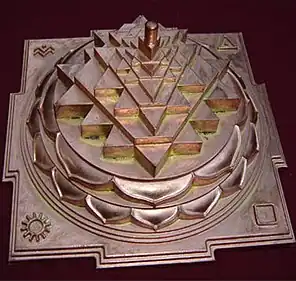Shri Vidya
Shri Vidya (ISO: Śrī Vidyā; lit. ''knowledge', 'learning', 'lore', or 'science'';[1] sometimes also spelled Sri Vidya or Shree Vidya) is a Hindu Tantric religious system devoted to the Goddess as Lalitā Tripurasundarī (Beautiful Goddess of the Three Worlds).

| Part of a series on |
| Shaktism |
|---|
 |
|
|
A thousand names for this form of Devī are recited in the Lalitā Sahasranāma, which includes Śrī Vidyā concepts.[2] The sect accepts and aims to provide both material prosperity and self-realisation. It has an extensive literature.[3] Details of belief vary in different texts but the general principles are similar to those found in Kashmir Shaivism.[4]
In the principally Shakta theology of Śrī Vidyā the goddess is supreme, transcending the cosmos that is her manifestation.[5] She is worshiped in the form of a mystical diagram (Sanskrit: yantra), a central focus and ritual object composed of nine intersecting triangles, called the Shri Yantra or Śrī Cakra.[6]
References
Citations
- Apte 1965, p. 857.
- For influence on the Lalitā Sahasranāma and a brief summary of some Śrī Vidyā practices see: Sastry 1986, pp. vii–ix.
- Bhattacharyya 1999, p. 329.
- Flood 1996, p. 188.
- For goddess as supreme and beyond the manifest cosmos, see: Flood 1996, p. 188.
- Flood 1996, pp. 187–188.
Works cited
- Apte, Vaman Shivram (1965), The Practical Sanskrit Dictionary (Fourth revised and enlarged ed.), Delhi: Motilal Banarsidass Publishers, ISBN 81-208-0567-4
- Bhattacharyya, N. N. (1999), History of the Tantric Religion (Second revised ed.), New Delhi: Manohar, ISBN 81-7304-025-7
- Flood, Gavin (1996), An Introduction to Hinduism, Cambridge: Cambridge University Press, ISBN 0-521-43878-0
- Sastry, R. Ananthakrishna (1986), Lalitāsahasranāma, Delhi: Gian Publishing House
Further reading
- Dempsey, Corinne G. (2006), The Goddess Lives in Upstate New York: Breaking Convention and Making Home at a North American Hindu Temple (first ed.), New York: Oxford University Press, ISBN 978-0-19-518729-8
- Dev, K. V., ed. (1996), The Thousand Names of the Divine Mother, San Ramon, California: Mata Amritanandamayi Center, ISBN 1-879410-67-2
- Joshi, L. M. (1998), Lalitā Sahasranāma, New Delhi: D. K. Printworld (P) Ltd., ISBN 81-246-0073-2
- Melanathuru, Venkata Subrahmanyam, Śhrī Vidya Upasana, Nellore, Andhra Pradesh
- Tapasyananda, Swami (1990), Śrī Lalitā Sahasranāma, Mylapore, Chennai: Sri Ramakrishna Math, ISBN 81-7120-104-0
